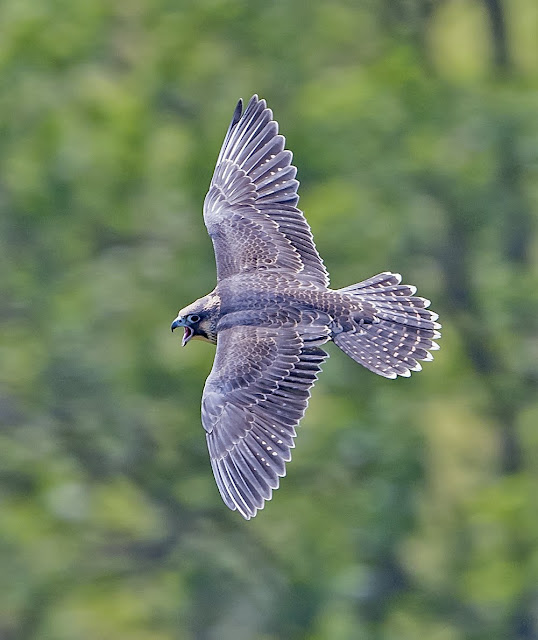After the disappointment of the Scarborough Peregrines' breeding failure this year, I turned my attention to some other birds which had successfully bred at Malham Cove in Yorkshire. And it's funny how things turn out as this has now just become my new favourite place to photograph Peregrines in a natural environment.
Right from the start I should say that all my photographs of these Schedule 1 birds were taken either from the limestone pavement or from the public footpath at the top of Malham Cove where I was regularly chatting with walkers and day trippers who passed by. Throughout the breeding season the RSPB have a Peregrine Watch at the foot of the Cove with spotting scopes pointing at the nest site which is widely publicised.
I'm very lucky because there is a Peregrine nest site only 10 minutes from my home, but it's in a town and so although it's great to have them here, most of my previous Peregrine photographs either have them in a nest box or on a building or just in the sky. And you can only have so many blue sky flight shots before it gets boring.
I prefer taking bird photographs in natural surroundings and the cliffs at Scarborough provide a great backdrop, particularly for flight shots. But Scarborough is two and a half hours drive for me and you do need to be there in the morning to get the light on the right side of the cliffs. So Malham, which is only one and a half hour's drive from my home now gets my vote for this type of photograph, especially when the sun is shining like it is at the moment. And better still, you can easily get at eye level and above the birds to get some overwing shots, instead of being underneath them all the time as at most other places.
This year two Peregrine chicks have fledged successfully and they are happily flying around the area around Malham Cove although still under the watchful eyes of their parents. At times the huge ampitheatre which is the Cove echoes with the sound of the birds screeching for food - a truly wonderful sound.
The chicks are brown compared to their parents' grey colour and so are quite easy to spot once you have got your eye in. There can be long waits between each flying session when the birds just sit perched on a rock ledge or in a tree and I was there for over six hours to get these shots with less than half an hour total flying time.
This enables the bird to breathe whilst in a stoop by reducing the change in air pressure. You can see the tubicles in the photo directly above. Jet engines were later developed with a cone in them just like the Peregrine's nostrils which allows the air to pass through at great speed in a very similar way. Once again, a human invention inspired by nature.
As I mentioned earlier, this is now the 'go to' place for all my Peregrine shots, and next year I'll be getting there even earlier the year to watch the events fully unfold. But I better let the bird have the last word.











great account and images from Malham Martin...nice to meet up yesterday!!!
ReplyDeleteThanks Paul, very nice to meet you. Hope we do so again!
ReplyDelete